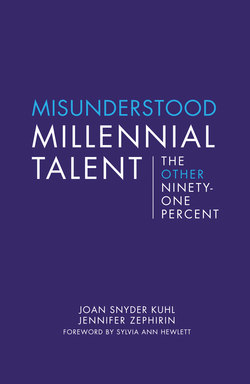Читать книгу Misunderstood Millennial Talent - Joan Snyder Kuhl - Страница 12
На сайте Литреса книга снята с продажи.
Оглавление2
Who is Flighty?
Do Millennials have one foot out the door? This was an assumption we elected to test. We surveyed 765 college-educated men and women, born between 1982 and 1994, working full-time in white-collar professions in the US. And we indeed uncovered a high incidence of flight risk.
But not among all Millennials. We had a hunch that socioeconomics matter—something for which we hadn’t tested in our original survey. So we re-fielded to a subset of our original sample. Our hypothesis bore out.
It turns out that, in our nationally representative sample, Millennials who have a financial safety net—those who have families that could support them indefinitely, were they to quit or lose their jobs, or who receive financial gifts from family members totaling at least $5,000 per year—are more likely than those who do not to say they plan to leave their jobs within a year. Fully 40 percent of these financially privileged respondents present, that is, a flight risk. Intuitively, this statistic makes sense: these men and women may be more inclined to explore other options because they can afford to take risks. They have a safety net at the ready should they fail.
But only 9 percent of Millennials, we find, have such a safety net. The vast majority—91 percent—do not have such financial privilege.
In some ways, this divide should be patently obvious. As noted in Chapter One, the wealth gap is far more pronounced for Millennials than for any prior generation. The US Gini coefficient—a measure of income inequality that shows where a country lies between zero (perfectly equal; everyone’s income is the same) and one (perfectly unequal; one individual receives all of the country’s income)—has been rising for decades, from 0.362 in 1967 to 0.464 in 2014.24 Put another way, the wealthy have gotten wealthier while the poor have gotten poorer: household income for the top 1 percent of households grew over twenty-four times as much as that of the bottom 20 percent between 1979 and 2007.25 And those dollars don’t stretch as far as they used to. Between 1978 and 2014, the cost of college tuition rose by over 1200 percent—as compared to a roughly 240 percent increase in prices for other consumer goods and services.26 With national student debt totals hitting $1.2 trillion in 2016, nearly 70 percent of bachelor’s degree recipients find themselves saddled with heavy financial burdens before they earn their first paychecks.27 Little wonder that, in the run-up to the 2016 presidential election, candidates like Bernie Sanders and Donald Trump managed to exceed expectations in winning the votes of Millennials: they tapped into a deep well of frustration among Americans who felt disenfranchised and disempowered by the wealthy and well-established elites in Washington and on Wall Street. 28
Millennials are, in other words, navigating an economic landscape utterly unlike the one Boomers and Gen Xers faced upon their entry into the workforce—a landscape in which socioeconomic status is as much a deciding factor in career mobility as race and gender are.
The upshot of this uneven financial playing field? The “flighty bunch” stereotype that talent specialists cling to in order to justify stingy budget allocations is grossly misapplied. Failure to take into account socioeconomic realities also explains why so much of the existing research on Millennials serves to amplify the stereotypes. Seen without the filter we applied for financial privilege, Millennials appear not only flighty but downright insatiable in their workplace needs and wants. As we shall see, for the Ninety-One Percent who lack financial privilege, nothing could be further from the truth.
Our research aims to overturn existing false assumptions by answering two critical questions: What do the Ninety-One Percent really need and want from their employers? And why should employers give it to them?
